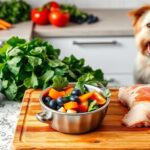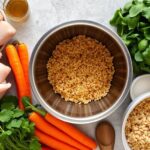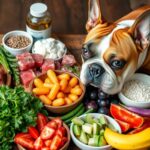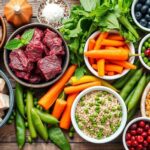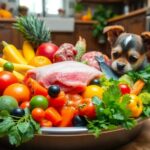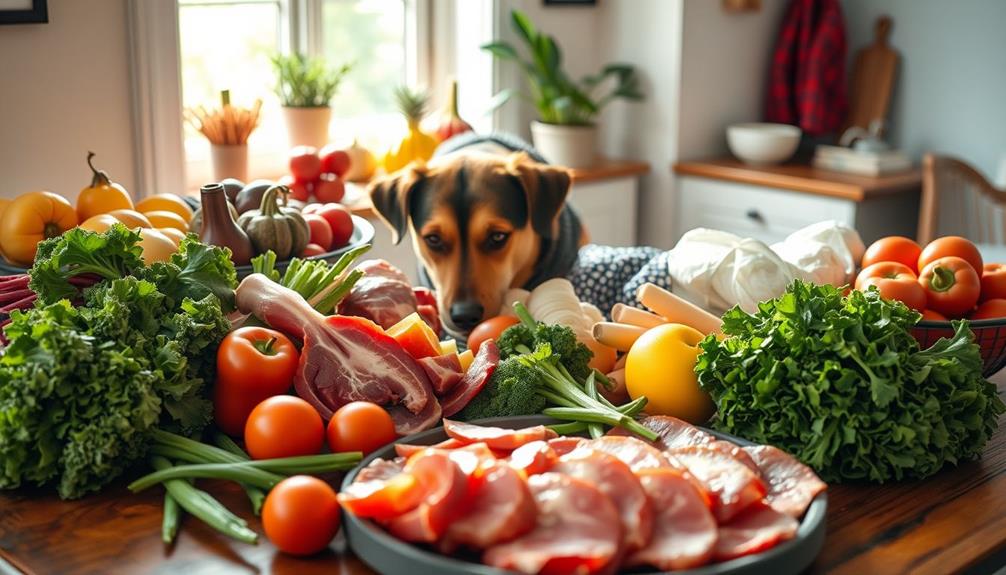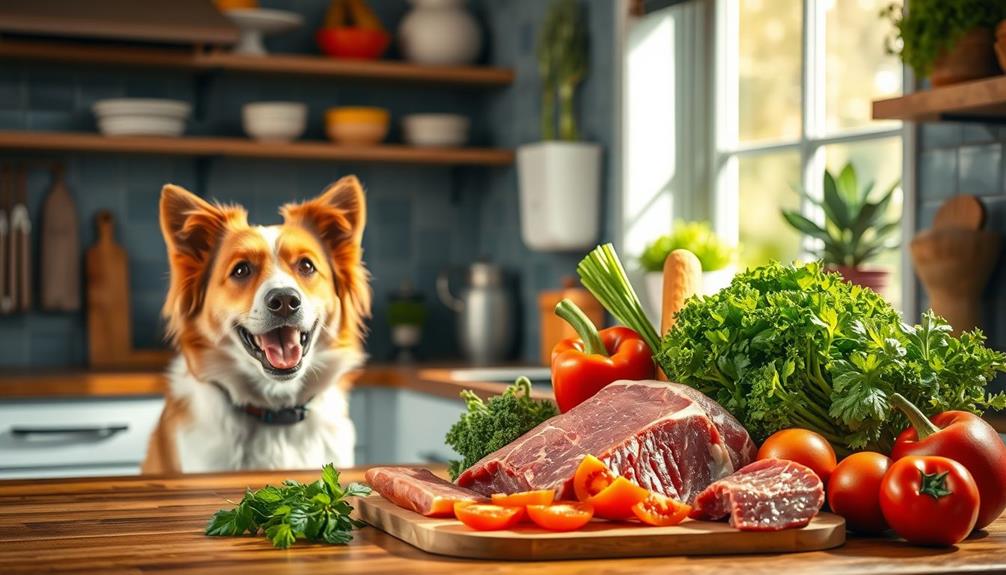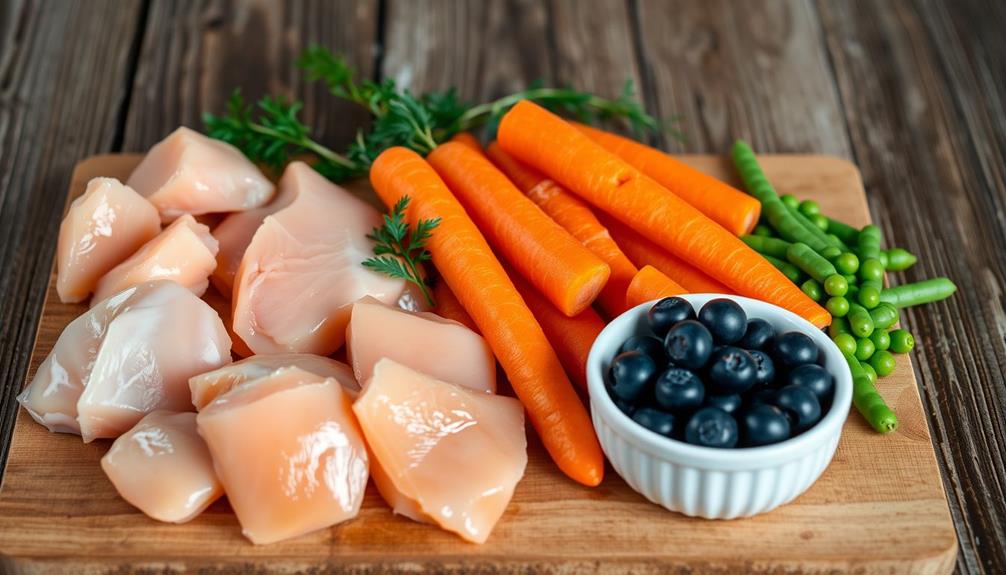Preparing raw food for your dog is simple and rewarding. Start with high-quality ingredients like 70% muscle meat (like ground beef or chicken), 10% organ meats (like liver), 10% raw bones, and 5% fresh veggies or fruits. An easy recipe could include mixing 2.5 lbs of ground beef, 4 oz of chicken liver, and some chopped vegetables. Gradually shift by mixing raw food with their old diet over 7-10 days to avoid digestive issues. Keeping an eye on your dog's reactions can help you adjust their meals perfectly. There's even more you can explore to guarantee your dog's health and happiness.
Key Takeaways
- Start with high-quality raw meats and organic ingredients to ensure maximum nutritional value for your dog's diet.
- Combine 70% muscle meat, 10% organ meats, 10% raw bones, and 5% vegetables/fruits for a balanced meal.
- Gradually transition to raw food by mixing it with dry food over 7-10 days to prevent digestive upset.
- Prepare ingredients by finely chopping vegetables and blending them with meats for better digestibility and nutrition.
- Monitor your dog's reactions and adjust recipes as needed to cater to their individual dietary requirements.
Benefits of Raw Dog Food
One of the key benefits of raw dog food is the enhanced control it gives you over your pet's diet. When you prepare homemade raw dog food, you can tailor the ingredients to meet your dog's specific health needs and food allergies. This personalized approach guarantees a balanced diet, promoting ideal health and nutritional value.
Additionally, understanding your dog's dietary preferences can help you select safe and nutritious ingredients, similar to how pet care requires awareness of safe snacks for hamsters.
Raw diets are known for their ability to improve digestion, leading to better nutrient absorption. You'll likely notice your dog experiencing fewer allergy symptoms and firmer stools, making clean-up easier for you.
Plus, the high meat content in these diets supports essential amino acid intake, vital for your dog's overall health.
Another advantage is healthier skin and shinier coats, which are often a direct result of the nutrient-rich ingredients you choose. By opting for raw feeding, you can also reduce reliance on commercial dog food, which may be of lower quality and subject to recalls.
This shift not only provides a safer dietary choice for your pet but also enhances their well-being. Ultimately, embracing raw diets can lead to a happier, healthier dog that thrives on a diet specifically designed for their needs.
Essential Ingredients for Recipes

When preparing raw food for your dog, choosing the right ingredients is crucial for their health and well-being. Start by focusing on muscle meat, which should comprise about 70% of their diet. Options like ground beef, chicken, or turkey provide the lean protein necessary for balanced nutrition. Including a variety of meats can also help prevent potential gastrointestinal issues that may arise from a lack of dietary diversity, as seen in juice diets.
Next, include 10% organ meats, such as liver and heart, to guarantee your dog receives essential vitamins and minerals.
Don't forget about raw edible bones! Aim for another 10% of their diet to consist of raw meaty bones, like chicken wings or necks. These not only supply calcium but also promote better dental health.
Incorporate 5% fresh vegetables and fruits, such as carrots and spinach, for added fiber and important nutrients. Be cautious to avoid harmful foods like onions and grapes.
Lastly, add 5% dairy or supplements, such as plain yogurt or fish oil, to boost nutritional value and provide omega-3 fatty acids, which are great for skin and coat health.
Easy Raw Dog Food Recipes
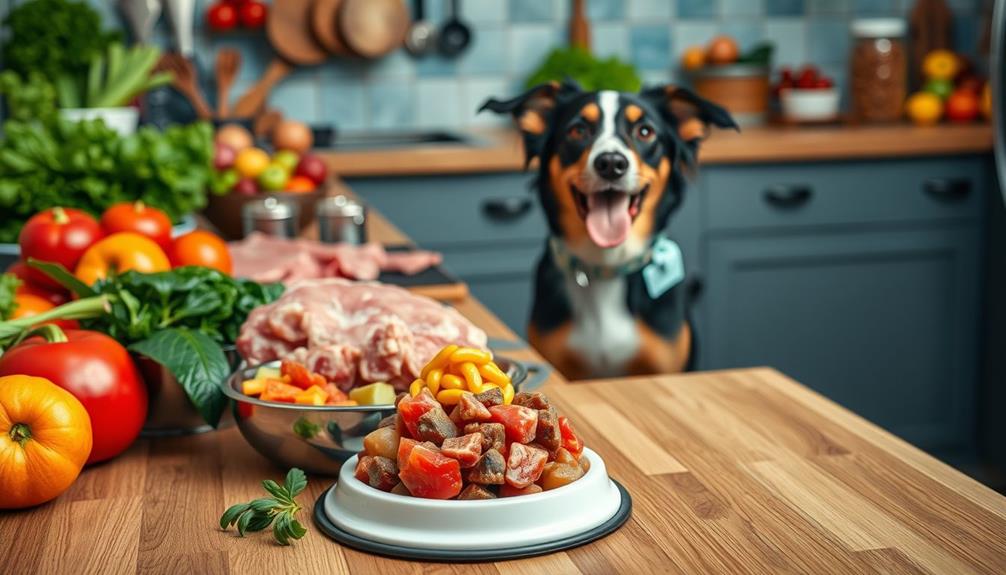
Creating easy raw dog food recipes at home can be a rewarding experience for both you and your furry friend. By using simple ingredients like ground beef, chicken livers, and fresh vegetables/fruits, you can whip up nutritious meals in about 30 minutes.
For a balanced homemade recipe following the BARF diet, try mixing 2.5 pounds of ground beef, 4 ounces of chicken livers, one chopped carrot, a cored small apple, and 1/2 cup of baby spinach. This combination provides around 3756 kcal per batch, perfect for adult dogs.
Additionally, it's vital to guarantee that you're aware of any potential health issues that can arise when changing your dog's diet, such as understanding the importance of nutrition in preventing diseases.
When preparing raw dog food recipes, keep in mind that a well-rounded meal should consist of 70% muscle meat, 10% raw edible bones, 10% organs, and 5% vegetables/fruits.
Monitoring your dog for any health issues is important as you shift to raw diets; start by gradually mixing the homemade food with their dry food.
Remember to follow portioning guidelines, feeding your dog 2-3% of their body weight daily. This guarantees they get the right nutrients while maintaining a healthy weight.
Enjoy the process, and watch your dog thrive on their new diet!
Feeding Guidelines for Dogs
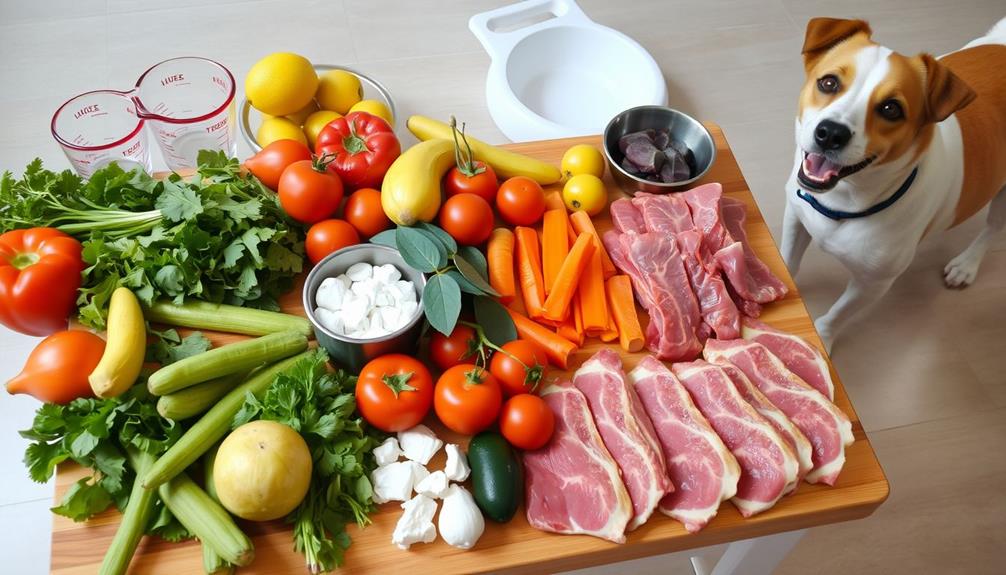
Establishing proper feeding guidelines for your dog is vital for their health and well-being. An appropriate raw food diet typically requires you to feed adult dogs 2-3% of their ideal body weight daily. For instance, a 50-pound dog generally needs about 1 to 1.5 pounds of food per day.
Puppies, on the other hand, have higher caloric needs; they should consume 2-3% of their expected adult weight or 5-6% of their current weight, with three meals daily until six months old. Additionally, incorporating healthy dog snacks into their diet can promote overall wellness and keep them satisfied. Senior and pregnant dogs may have specific nutritional requirements that warrant a discussion with your veterinarian.
Additionally, every dog's activity level plays a significant role in determining their food intake. Active dogs will likely need larger feeding portions compared to those that are more sedentary.
Regularly evaluate your dog's weight and condition to adjust feeding portions accordingly. This practice not only guarantees ideal health but also helps in managing their body weight effectively.
Preparation and Transition Tips

When shifting your dog to a raw diet, it's vital to do it gradually, mixing raw food with their current dry food to ease their digestive system.
Incorporating a variety of fresh ingredients is necessary for a well-rounded nutritional profile, as certain essential oils for pets can support health during this shift.
You'll also want to prepare ingredients carefully and control portions to guarantee a balanced diet.
Let's explore how to make this move smooth and effective for your furry friend.
Gradual Diet Transition
To smoothly shift your dog to a raw food diet, start by gradually mixing homemade raw meals with their current dry dog food over a span of 7-10 days. This gradual diet change helps prevent digestive upset. You can feed one meal raw and another dry during this period, allowing your dog's digestive system to adjust comfortably.
Here's a simple schedule to follow:
| Day | Meal 1 (Raw) | Meal 2 (Dry Dog Food) |
|---|---|---|
| Day 1-3 | 25% raw, 75% dry | 100% dry |
| Day 4-6 | 50% raw, 50% dry | 100% dry |
| Day 7-10 | 75% raw, 25% dry | 100% dry |
During this change, monitor your dog's reactions closely. Watch for any changes in stool consistency or appetite, adjusting the recipe as needed for nutritional adequacy. Establish a routine by consistently incorporating homemade raw meals into your dog's bowl, creating familiarity and comfort with the new diet. The good news is that with patience and attention, your dog will thrive on raw edible meals!
Ingredient Preparation Techniques
Your dog's nutrition starts with proper ingredient preparation, which is essential for a successful raw food diet. Begin by creating an ingredient list that includes fresh, high-quality raw meat, organic muscle meat, and organ meats. These whole foods maximize nutritional value and are high in omega fatty acids, vital for your pup's health.
Additionally, confirming your dog is healthy and free from infections before starting a new diet is important; piercing care and hygiene can be a good parallel to take into account for overall health awareness. When incorporating vegetables, process options like green beans, carrots, and apples until finely chopped to guarantee digestibility.
Mix the finely chopped vegetables with the ground meat and organ meats thoroughly to create a balanced blend that aligns with the prey model diet. This allows you to make your own raw meals tailored to your dog's nutritional needs.
Once blended, form the mixture into patties about the size of your palm and place them on a parchment-lined baking sheet before freezing. This step helps maintain freshness.
If you're shifting your dog from commercial raw to homemade, do it gradually. Start by mixing the new raw food with their current diet, monitoring their reactions closely. Adjust the recipe as needed to cater to individual preferences and health requirements, guaranteeing a smooth change to this healthier feeding approach.
Portion Control Guidelines
Establishing portion control is essential for ensuring your dog receives the right amount of nutrition while changing to a raw food diet. To determine portion sizes, feed adult dogs 2-3% of their ideal body weight daily. For a 50-pound dog, that means 1 to 1.5 pounds of food.
Puppies should eat 2-3% of their expected adult weight or 5-6% of their current weight, with a feeding schedule of three meals daily until six months old. Additionally, understanding the nutritional needs of your dog can be beneficial, especially when considering financial considerations for elderly care regarding providing the best diet for your pet.
Here are three key tips to help you with portion control:
- Monitor Activity Levels: Active dogs may need more food to maintain energy, so adjust portions accordingly.
- Gradual Introduction: Start by mixing homemade food with your dog's dry food. Change slowly to minimize digestive issues.
- Consistent Feeding Schedule: Stick to a regular feeding schedule to help your dog feel secure and adjust better to the new raw diet.
Expert Support and Resources
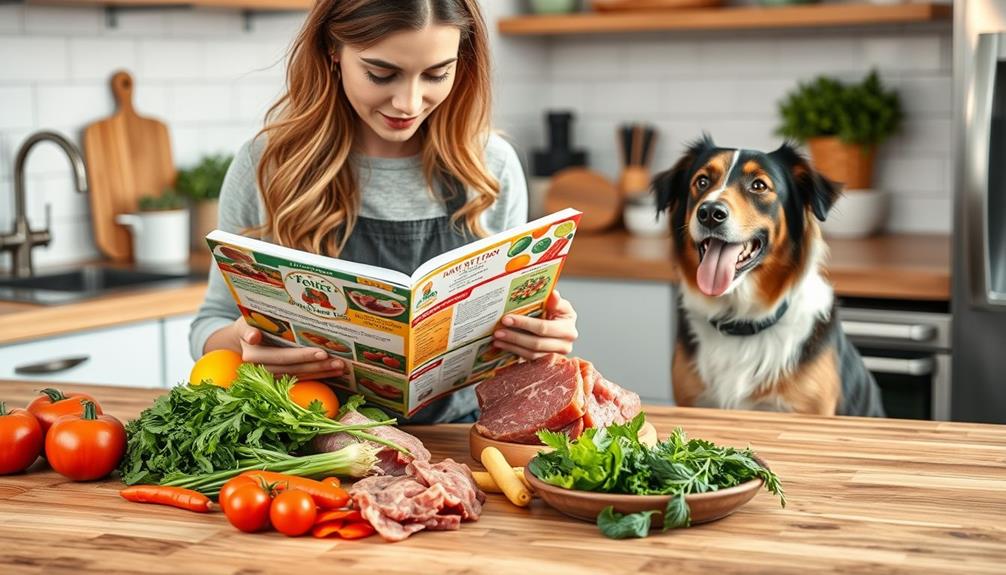
When you're shifting your dog to a raw food diet, expert support can make all the difference.
Understanding the importance of a budget for managing expenses related to your dog's dietary needs can help you make informed choices.
You can schedule one-on-one online consultations with Dr. Conor Brady, who offers personalized advice tailored to your dog's needs.
Plus, joining a community of fellow dog owners provides ongoing support and shared experiences to help you along the way.
Online Consultations Availability
For dog owners looking to shift to a raw food diet, online consultations offer invaluable support and resources. With experts like Dr. Conor Brady, you can access personalized support tailored to your dog's specific health needs, food allergies, and dietary changes.
Understanding the importance of key domains of development in psychology can enhance your approach to your dog's nutrition, ensuring their emotional and physical growth is supported.
Here's why you should consider booking a consultation:
- In-Depth Analysis: You'll spend up to 40 minutes discussing your dog's unique requirements, ensuring you understand the nutritional information needed for a balanced raw food diet.
- Tailored Tips: After your session, you'll receive a summary email with tailored tips and a detailed diet plan, making it easier to implement changes.
- Ongoing Support: You'll have the option for follow-up support, ensuring you're never alone during this change.
Each one-hour session is conducted via platforms like Zoom or Skype, making it convenient for you.
With a short preparation segment followed by a thorough discussion, you'll leave feeling confident about what your dogs eat and how to best meet their dietary needs.
Embrace this opportunity for a healthier lifestyle for your furry friend!
Community Support Options
Community support options play an essential role in your journey to feeding your dog a raw diet. By connecting with dog nutrition experts through online consultations, like those offered by Dr. Conor Brady, you can receive personalized guidance tailored to your dog's specific needs. This expert advice is invaluable, especially for new raw feeders traversing the adjustment process.
Engaging with sound quality and levels can help you understand the importance of providing balanced nutrition for your pet's health.
You'll find a wealth of educational materials available to help you understand the intricacies of raw feeding. Many testimonials from satisfied pet owners showcase the incredible health transformations their dogs experienced after implementing expert nutritional advice. These success stories can motivate you and provide reassurance as you set out on this journey.
Additionally, subscription platforms offer continuous learning opportunities, delivering new recipes and health tips directly to your inbox. Being part of a support network allows you to address any health questions or concerns you might have, ensuring you have access to knowledgeable assistance throughout your raw feeding experience.
Embrace these community support options, and you'll feel more confident in your ability to provide the best nutrition for your furry friend.
Frequently Asked Questions
How to Prepare Raw Food for Dogs at Home?
To prepare raw food for dogs at home, gather fresh ingredients, chop them finely, mix thoroughly, form patties, freeze them, and monitor your dog's reaction during the shift to guarantee a smooth adjustment.
How Do You Raw Feed a Dog for Beginners?
Ever wondered how to start raw feeding your dog? Begin gradually, mixing raw with their current food. Balance their meals with meat, bones, and veggies. Monitor their health and adjust portions based on their needs.
What Is the Formula for Raw Food for Dogs?
The formula for raw food for dogs involves 70% muscle meat, 10% raw bones, 10% organs, 5% veggies/fruits, and 5% dairy. Adjust portions based on your dog's ideal weight for balanced nutrition.
What Are the Best Ingredients to Put in Homemade Dog Food?
Imagine your dog's bowl as a vibrant canvas. Fill it with 70% muscle meat, 10% organ meats, 10% raw bones, 5% fruits and veggies, plus a splash of dairy or supplements for a balanced masterpiece.
Conclusion
Incorporating raw food into your dog's diet can lead to a healthier, happier hound. By understanding the benefits and essential ingredients, you'll create scrumptious, safe meals that satisfy your pup's needs. Remember, shifting takes time, so be patient and persistent. With proper preparation and a sprinkle of support, you'll foster a fantastic feeding routine. Embrace this exciting endeavor, and watch your furry friend flourish with every flavorful bite!



